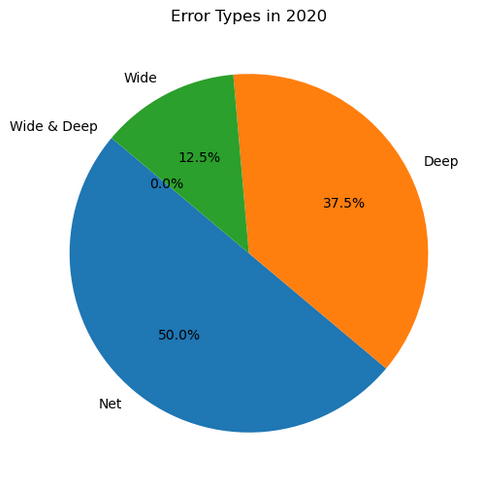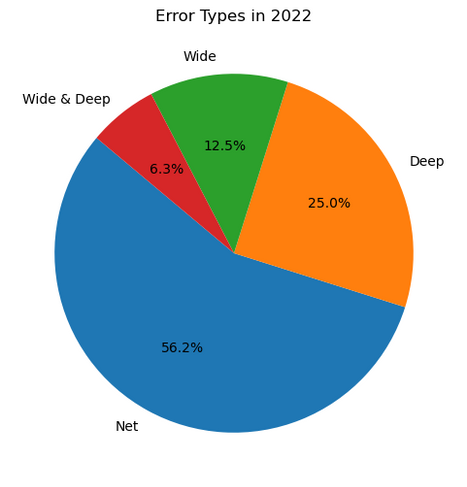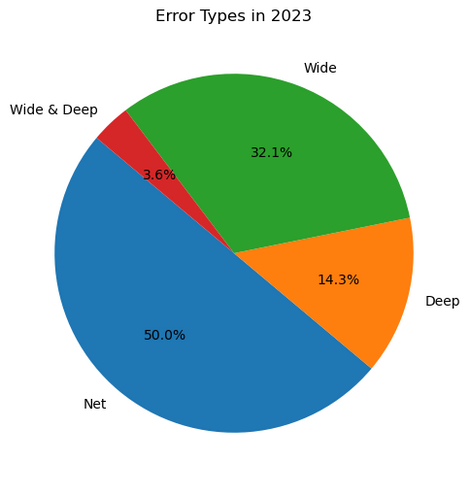Coco Gauff's 2023 Breakthrough
- Bruin Sports Analytics

- Dec 19, 2023
- 8 min read
By: Sofia Jain and Angelina Muliadi
Introduction
In the dynamic world of women’s tennis, a standout personality has captured the spotlight in recent years–Cori ‘Coco’ Gauff. Born in Delray Beach, Florida, in 2004, Gauff entered the tennis scene as a child prodigy. Yet, it was not until her breakthrough season in 2019 that she found herself in the spotlight for her first Grand Slam appearance at Wimbledon, at the young age of 15. As with many athletes’ stories, Gauff’s journey has not always been easy, which was marked by a challenging period in her career where she lacked consecutive wins and was not dominating her opponents like she had been earlier in her career. This “slump” occurred early in 2023 and even resulted in a coaching change. With her new coach, Brad Gilbert, Coco Gauff resurrected her tennis season and in this article, we will explore how she went from this period in her career to becoming a Grand Slam champion in a matter of a year.
Methodology
Defining Tennis Terminology
Before delving into the depths of Gauff’s career, it is essential to understand the terminology that shapes the sport. What does it mean when a player experiences a ‘slump’? How does a forehand differ from a backhand? What are the different types of errors? These will be the foundation of the analysis.
Slump - Period which lacks win consistency
Forehand - A racket swing where the palm of the player holding the racket faces the same direction as the hit
Backhand - A racket swing where the back of the hand holding the racket faces the same direction as the hit
Error - A mistake that results in the opponent winning a point. A forced error is one in which the opponent’s move produces the error. An unforced error is one in which the player’s own move or mistake produces the error.
Returns - Hitting a ball to play after an opponent’s serve
Methods of Analysis
To analyze Coco Gauff’s tennis career and her recent rise to becoming a Grand Slam winner, we utilized WTA matches charted by Jeff Sackman. Specifically, we used data related to Coco’s win/loss streaks, serve, return, forehand, backhand, and error types. A limitation of our data to note is during the peak of the COVID-19 pandemic in 2020, numerous tennis matches were canceled, resulting in a dataset from those years having fewer matches than a typical year. A second limitation to consider is that the datasets pertaining to the in depth statistics of her return, errors, forehand/backhand, etc is not comprised of all of her matches but rather the ones that were charted on this public resource.
For our analysis and visualizations, we used computer programming in Python to help identify any significant differences in Coco’s game that could explain her remarkable success at the end of 2023.
Analysis
Win/Loss Streak Analysis
Throughout the years Coco Gauff has reached a highest win streak of up to 15 and minimized her highest losing streak to 2. Her winning streaks in 2021 and 2022 follow a similar pattern, where her consecutive wins seem to coincide with clay court tournaments. In 2023, her longest win streak occurred at the end of the year during the hard-court swing of the tour, whereas in previous years she struggled to reach over 5 consecutive wins in this section of the tour.
Interestingly, in 2023, Coco started and ended the year with significant winning streaks, with only a few losing streaks of at most two in between. In contrast, in previous years, Coco did not start or end the year with as many consecutive victories, and her success seemed more pronounced during clay court tournaments. It’s possible her recent adjustments to her game are more refined and suited for the hardcourts than the clay. Additionally, it’s plausible that Coco has acclimated to the challenging lifestyle of a professional tennis player and is able to be competitive all year long.
Looking ahead, a future point of analysis could explore whether the observed decline in wins during the clay court tournaments remains a significant pattern or not.

Forehand Analysis
Throughout Coco’s career, the media and analysts have pointed out weaknesses in Coco’s forehand. This is evident in the fact that up until 2023, she has a trend of producing more unforced errors on forehand swings than winners. In a particular match in 2022, her unforced errors got to as high as 35, compared to only 14 forehand winners. An ideal winner to unforced error is 1:1, but in this match, the ratio was over 1:2, highlighting a true vulnerability in Coco’s forehand.

In 2023, a gradual improvement is notable. Her unforced error count and winners count on the forehand swing begin to even out. Initially in 2023, during a slump up until Rome, she got up to 10 more unforced errors than winners on the forehand. However, she turned that trend around and ended the year with a more balanced winner to unforced error ratio on the forehand.
Backhand Analysis
Coco’s backhand winner to unforced error ratio has shown a more favorable balance compared to her forehand. While she still has produced a notable number of unforced errors on her backhand swings, the number of winners in these matches are similar. The ratio is not as lopsided as it is for her forehands. Overall, detailing a clear trend is challenging, but toward the end of 2023, there are fewer instances where her unforced error total surpasses her winner total for her backhand.
It is also evident that the highest count of unforced backhand errors in a single match has decreased from 20 in 2020 to around 15 in 2023. Overall, Coco’s backhand does not seem to be as pronounced of a weakness as her forehand, suggesting that it might not have been the main focus of her efforts to improve her overall game.

Return Analysis
First, analyzing Coco Gauff’s deep returns, through the visualization we notice that her returns have been stable when it comes to deep returns. The stability in average deep returns suggests a reliable and controlled approach when it comes to her confidence in her returns. This indicates that Coco is able to handle shots played toward the baseline with greater stability from when she started playing up until 2023.

Contrastingly, we notice a decrease in the average shallow returns in Coco’s returns throughout the years. As a player known for her powerful groundstrokes, the reduction in shallow returns could suggest a conscious effort to optimize shot selection and placement to minimize unforced errors. By decreasing shallow returns, she appears to be focusing on placing the ball more strategically within the court, aiming for locations that challenge opponents and set her up for advantageous follow-up shots. This showcases her increasing IQ and tactical maturity within the game.

Error Type Analysis
In 2020, Coco’s errors show a divide between the types, with 50% of errors occurring at the net. This suggests that she struggled to find a balance between aggressive net play and precise shot execution. The subsequent year, 2021, painted a picture of heightened inconsistency as wide errors surged to 46.2%. Despite this, a silver lining emerged with a noticeable decrease in net errors, indicating a potential shift in tactical approach. However, the increase in wide shots shows growing concern as most shots are played behind the baseline rather than the net.
The year 2022 witnessed incremental improvements, with a reduction in net errors and a more balanced distribution across wide, deep, and wide & deep categories. This trend highlights her consistent progress and contributes to her development as a more well-rounded player. On average, her shots are becoming increasingly error-free, indicating the absence of any particular weak link in her arsenal. From 2022 to 2023, wide errors dropped to 32.1%, deep errors to 14.3%, and net errors to a mere 3.6%. This remarkable improvement in error distribution showcases a comprehensive shift in Coco’s gameplay.
The trends within her error types each year show that Coco implemented strategic adjustments to address the issues identified in the preceding years. Refining shot selection, improving net play, and focusing on overall consistency were likely key elements of this evolution.
Serve Analysis
Our final point of analysis focuses on Coco Gauff’s serve, specifically concentrating on the period of her 2023 slump from the Australian Open to Rome and the subsequent phase of success from Eastbourne to the US Open to identify what, if any, metrics improved.
In the accompanying visualization, we observe an uptick in her double fault count, rising from 55 to 73, while her ace count shows a minute uptick of 4. In tennis, double faults hold greater weight on the outcome of the point than aces, as they result in an immediate loss of points for the server. On the other hand, aces suggest a powerful serve, and it is clear Coco has done a good job of maintaining the ability to secure easy points on her serve.
The overall increase in double faults does not emerge as a dominant factor affecting her ability to end the year with genuine success. Though, it is worth noting that reducing double faults could be an area where Coco could further improve on to maintain effective service games.

Next, we examine the disparities in break point metrics. A break point occurs when the returner only needs one more point to win the game, which gives rise to extreme pressure on the server. Tennis players emphasize avoiding or extricating themselves from this situation as much as possible. Markedly, Coco successfully reduced the number of break points she faced after her slump.
Furthermore, she saved fewer break points after her slump, but this could be attributed to facing a lower total number of break points in the first place. By lowering the amount in which Coco found herself in the unpleasant situation of almost being broken on her serve, Coco effectively mitigated the stress and occasional nervous play that tennis players often experience in such situations. This could contribute to more confidence and success during her service games which can help a tennis player get out of a slump.

Lastly, we examine points won on the first and second serve. Post-slump, Coco won slightly more points on her first serve than during the slump. More notably, on her second serve, Coco had an improvement of winning 47 more points. While a tennis player prefers to win points on the first serve, the ability to also succeed on the second serve adds to the flexibility and strength of a player’s overall game. For Coco, this improvement helps her win points even when she can’t rely on her first serve. Similar to facing fewer break points, increasing the number of points won on the second serve also contributes to a player’s confidence in their ability to win points during service games in less than ideal situations.

Conclusions/Improvements/Limitations
In conclusion, Coco Gauff’s tennis journey showcases a huge improvement in her game. Her service games have rebounded impressively the years post-slump, with fewer break points faced and improved second-serve points won. However, an increase in double faults suggests an area for targeted improvement. The forehand has shown overall improvement, while the backhand remains consistent. Strategically, Gauff has decreased the frequency of shallow returns, showcasing an increasingly mature approach to shot selection and placement. In terms of errors, her game exhibits a commendable balance, lacking any glaring weaknesses, except, to a lesser extent, at the net—an uncommon focal point in today's baseline-oriented tennis.
Moreover, it is important to acknowledge the limitations of our analysis. The dataset didn't track all matches for most of our analysis, restricting a comprehensive examination. We could only thoroughly analyze the serve since the other datasets only tracked a few matches in 2023, not all of them. Additionally, the 2020 data is only available for a limited number of matches. Despite these limitations, the trends observed offer valuable insights into Gauff's game.














Comments